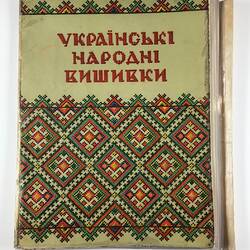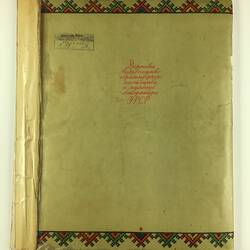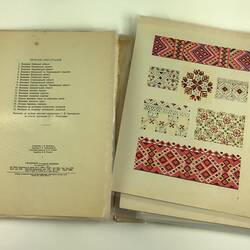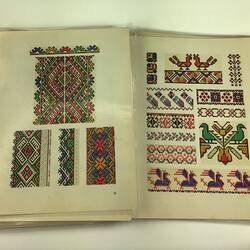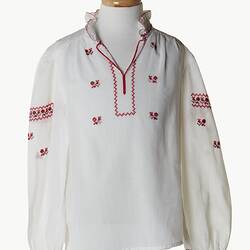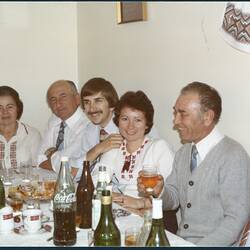Summary
Folder with geometric pattern entitled (translated from Ukrainian) 'Ukrainian National Embroidery', published in Soviet Union, 1961. It contains 19 full colour laminated sheets laminated by Natalie to protected them from constant use by other women referring to the patterns.
The folder was a gift from Nicholas Diduh, a Ukrainian friend of Natalie Senjov Makohon's parents to encourage her to pursue the craft. Mr Diduh migrated from Bosnia to Australia at the same time as Natalie's parents. Natalie and her mother Katerina's designs were influenced by the patterns in this publication. Many of the pieces they gifted were copied from the patterns in this publication. This publication influenced Natalie's creative flare.
This item is part of a collection of textiles, cultural objects and photographs relating to the migration and settlement experiences of Katerina Senjov, and her daughter Natalie Senjov-Makohon who inherited her mother's passion for maintaining her Ukrainian cultural heritage.
Katerina Senjov (nee Burlak) and her husband Peter migrated to Melbourne from what is now Bosnia-Herzegovina in 1954. Despite growing up in Bosnia, the Senjov and Burlak families always culturally identified as Ukrainians and spoke Ukrainian.
They settled first in Geelong and then in Ascot Vale, had two children Natalie and Steven, whom they encoraged to learn traditional Ukrainian culture and traditions. The Senjovs actively participated in the Ukrainian community (including choirs, dance groups and gatherings wearing traditional regional clothing usually made by Katerina or her daughter Natalie).
The mother and daughter produced, wore, used, purchased and received, a range of Ukrainian cultural items including embroidered domestic and religious textiles, Ukrainian textile design publications, Pysanky (hand-painted eggs), a Bandura (stringed musical instrument) and timber inlay artworks.
Physical Description
Laminated folder pale green cover with geometric pattern with Ukrainian script; contains 19 full colour laminated sheets of traditional Ukrainian textile designs. Handwritten text on inside of cover, frontispage and back of each sheet. Each sheet has a number of patterns in multi-coloured ink and a numeral in black at bottom right corner.
Significance
This collection provides a significant representation of traditional Ukrainian life and cultural practices subsequently transported to Australia through migration, and retained as part of the preservation, maintenance and adaptation of cultural life. In this family there was a strong and active passing down of cultural traditions, particularly down the female line.
The Museum holds a range of regional costumes, or costume components, from Sardinia, Latvia, Estonia, Poland, South Africa, Albania, Scotland, Greece, Hungary, Slovenia and Argentina; this collection relating to Ukraine further strengthens and expands the cultural representation of the collection. This material has been worn and used, is well provenanced, and has accompanying photographic documentation. This collection is also an important addition to the currently small collection relating to Ukrainian migration and settlement experiences.
The collection also includes domestic and religious Ukrainian embroidery and weaving, books documenting traditional Ukrainian designs used as references by the makers in Australia, Pysanky (painted eggs) in the tradition of many eastern European countries including Ukraine, and a Bandura (Ukrainian traditional musical instrument).
These items were all of importance in the expression of identity and place, some in the country of origin, and all in the place of re-settlement. Some of the costume pieces have played a role in the activities of community organisations in Australia; like similar associations, maintaining cultural practices and customs is increasingly challenging as subsequent generations become further distanced from the original migrant generation and through the natural process of community settlement, integration and assimilation within the context of a multiculturally diverse society.
More Information
-
Collection Names
-
Collecting Areas
Migration & Cultural Diversity, Clothing & Textiles, Home & Community, Leisure
-
Previous Owner
Natalie Senjov-Makohon, Melbourne, Victoria, Australia, 2024
-
Date Published
-
Inscriptions
Cover of folder: [Ukrainian script]. Handwritten inside and rear of sheets: 'Natalie Makohon'
-
Classification
Cultural identity, Ethnicity - creative practice, Needlework
-
Category
-
Discipline
-
Type of item
-
Overall Dimensions - Closed
290 mm (Width), 360 mm (Height)
-
Keywords
Ukrainian Immigration, Folk Festivals, Needlework, Handcrafts, Cultural Traditions, Embroidery, Weaving, Sewing, Cultural Identity, Artworks, Crafts

